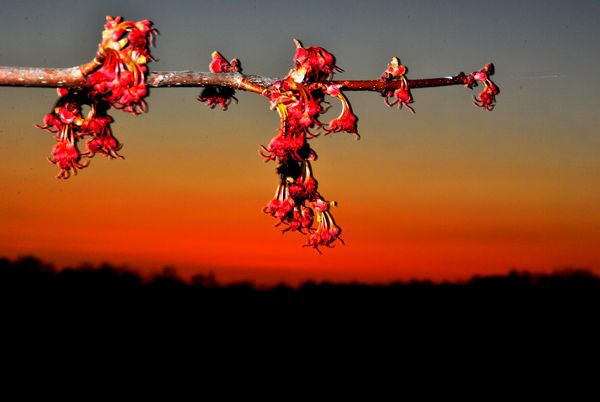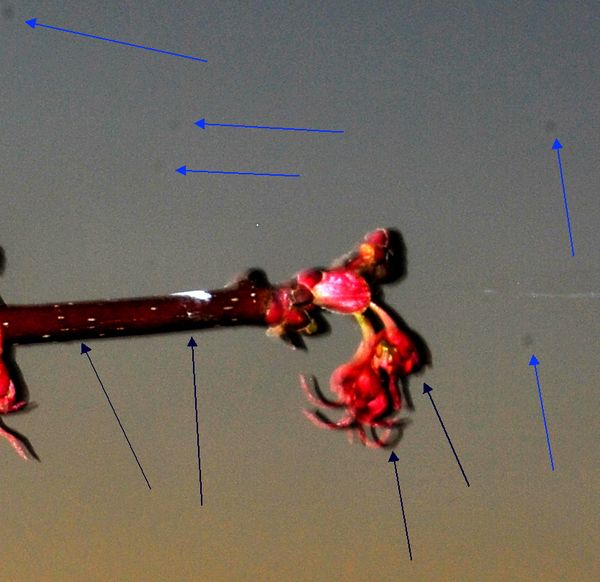Why do I get these Strange shadows
Mar 18, 2012 21:06:47 #
I was experimenting tonight shooting with the kit lens on my Nikon D3000. I was using the built in flash. Shooing toward the sky.
Why are there shadows as if there is a wall behind the flowers. It is like it is casting shadows in the air.
Do I have this in the right place English Wolf? :-)
Why are there shadows as if there is a wall behind the flowers. It is like it is casting shadows in the air.
Do I have this in the right place English Wolf? :-)

Mar 18, 2012 21:13:50 #
The problem you have is the on camera flash is above the flowers and creates a drop down shadow. Sometimes, in cases like this, it pays to turn the camera upside down. Due to the narrow distance between the flowers branch and the vertical surface I doubt this will help much.
One interesting aspect is that you took this close against a wall/picture. Use a white piece of paper to open the shadows.
Focusing and DOF is not quite right. This would gain by being taken further away from the wall/picture but may also create other problems, if the picture used as background is not large enough.
You may want to PP the paper scratches too...
One interesting aspect is that you took this close against a wall/picture. Use a white piece of paper to open the shadows.
Focusing and DOF is not quite right. This would gain by being taken further away from the wall/picture but may also create other problems, if the picture used as background is not large enough.
You may want to PP the paper scratches too...
Black: flash drop shadows, Blue dust on sensor.

Mar 18, 2012 21:34:43 #
English_Wolf wrote:
The problem you have is the on camera flash is abo... (show quote)
No paper scratch. This was taken outside with the nothing between it and the sunset across the field.
Ugh. On the sensor spots. I guess I am going to learn how to clean my sensor now.
Mar 19, 2012 02:54:58 #
Country's Mama wrote:
quote=English_Wolf The problem you have is the on... (show quote)
We need Sherlock Holmes here, and we need him fast, before I scratch a hole in the top of my head!
Everything I see tells me English Wolf is right, but YOU were there when the picture was taken! Aaurghh...
Mar 19, 2012 08:37:55 #
I also think the "paper scratch" was a cobweb from looking at some of the other pictures.
Mar 19, 2012 08:39:28 #
Danilo wrote:
quote=Country's Mama quote=English_Wolf The prob... (show quote)
Yep. I was out side. I did not bring a branch of my maple tree inside, nor take any thing outside other than the camera. Strange.
Mar 19, 2012 09:00:17 #
I think you had the flash on full power. Probably why the branch is so blasted looking.
Use flash compensation to knock the flash level down a bit. You just want a bit of fill flash to lighten up the branch. Although, it could look pretty neat in silhouette against the setting sun.
Use flash compensation to knock the flash level down a bit. You just want a bit of fill flash to lighten up the branch. Although, it could look pretty neat in silhouette against the setting sun.
Mar 19, 2012 09:24:45 #
Hammster wrote:
I think you had the flash on full power. Probably why the branch is so blasted looking.
Use flash compensation to knock the flash level down a bit. You just want a bit of fill flash to lighten up the branch. Although, it could look pretty neat in silhouette against the setting sun.
Use flash compensation to knock the flash level down a bit. You just want a bit of fill flash to lighten up the branch. Although, it could look pretty neat in silhouette against the setting sun.
I don't think I have any control over the strength of the flash. I could be wrong. It is the built in flash on the camera.
Even so. Why am I getting a shadow when there is nothing there to cast a shadow on?
Mar 19, 2012 09:33:58 #
Check pages 78 and 79 of your user's manual on how to set flash compensation. At least it is those pages in the pdf version I found online.
The only shadow I see is what is caused by the flash being slightly above the branch as English Wolf mentioned. Those shadows will lessen as you reduce flash compensation.
The only shadow I see is what is caused by the flash being slightly above the branch as English Wolf mentioned. Those shadows will lessen as you reduce flash compensation.
Mar 19, 2012 09:47:15 #
Hammster wrote:
Check pages 78 and 79 of your user's manual on how to set flash compensation. At least it is those pages in the pdf version I found online.
The only shadow I see is what is caused by the flash being slightly above the branch as English Wolf mentioned. Those shadows will lessen as you reduce flash compensation.
The only shadow I see is what is caused by the flash being slightly above the branch as English Wolf mentioned. Those shadows will lessen as you reduce flash compensation.
But why is there a shadow at all. There is nothing to cast a shadow on? I would understand the shadow if there was a wall behind the branch, but there is nothing.
Mar 19, 2012 09:52:16 #
My humble opinion. Your subject is 3 dimensional so a shadow can be cast. I love the shot and even the shadow contributes to the hour of the day and the depth perception. Again, my opinion.
Mar 19, 2012 09:52:55 #
Danilo wrote:
quote=Country's Mama quote=English_Wolf The prob... (show quote)
I have gotten a similar result when photographing a subject indoors when I use flash but also use a long shutter speed to burn in the ambient light in the background and either I do not use a tripod and I move my camera or the subject moves during the time exposure. An example of this is a bride standing in the aisle of the church near the entry doors to the chapel. The altar is far behind her and filled with flowers and natural lighting and I want both the bride and the background illuminated. In your case if you did use a slower shutter speed to burn in the sky then the flash would capture and freeze the tree limb/buds and the slower shutter speed would allow the sky to be exposed. If that was the case it looks like you may have moved your camera to the left side immediately after your flash fired. The result is that when the shutter remained opened to burn in the sky the buds on the limb (which I assume were in darkness after the flash fired) blocked the area of the sky not allowing them to register on the sensor giving you what looks like a shadow.
The previous comment about shooting against a wall makes send here (eventhough it was the real sky and not a wall). If you look at the far right side of the image you will see that in some areas the shadow is not on the side of the bud but it is even further to the right appearing like a shadow on the wall. This is a result of the camera moving to the left after the flash fired thus the bud then moved to the right on the sensor during the time exposure blocking the sky as it registered on the sensor. That is why it appears as a shadow on a wall. Next time try a tripod and make sure the air is calm and the branch is still.
Mar 19, 2012 09:56:15 #
Bloomfield Ron wrote:
quote=Danilo quote=Country's Mama quote=English... (show quote)
That makes sense. That is exactly what I was doing. I actually had the tripod out, but wasn't using it. Next time I will actually put the camera on the tripod :roll:
Mar 19, 2012 10:10:34 #
Mar 19, 2012 10:12:39 #
Country's Mama wrote:
quote=Hammster I think you had the flash on full ... (show quote)
Could it be that you moved when taking the shot?
If you moved, the flash would "freeze" part of the shot but you'd also see the "ambient" exposure also...
Just wondering.
If you want to reply, then register here. Registration is free and your account is created instantly, so you can post right away.





